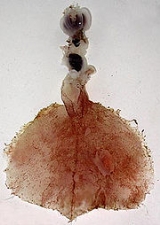
Magnapinna sp. B
Encyclopedia
Magnapinna sp. B is an undescribed species of bigfin squid
known only from a single immature specimen collected in the northern Atlantic Ocean
. It is characterised by its dark epidermal
pigmentation, which is epithelial
, as opposed to the chromatophoral
pigmentation found in other Magnapinna species.
The only known specimen of Magnapinna sp. B is a juvenile male of 95 mm mantle
length (ML) held in the Bergen Museum
. It was caught by the R/V G.O. SARS (MAR-ECO cruise super station 46, local station 374) on July 11, 2004 at 42.8°00′N 29.3°00′W.
Bigfin squid
The bigfin squids are a group of rarely seen cephalopods with a distinctive morphology. They are placed in the genus Magnapinna and family Magnapinnidae...
known only from a single immature specimen collected in the northern Atlantic Ocean
Atlantic Ocean
The Atlantic Ocean is the second-largest of the world's oceanic divisions. With a total area of about , it covers approximately 20% of the Earth's surface and about 26% of its water surface area...
. It is characterised by its dark epidermal
Squamous epithelium
In anatomy, squamous epithelium is an epithelium characterised by its most superficial layer consisting of flat, scale-like cells called squamous epithelial cells...
pigmentation, which is epithelial
Epithelium
Epithelium is one of the four basic types of animal tissue, along with connective tissue, muscle tissue and nervous tissue. Epithelial tissues line the cavities and surfaces of structures throughout the body, and also form many glands. Functions of epithelial cells include secretion, selective...
, as opposed to the chromatophoral
Chromatophore
Chromatophores are pigment-containing and light-reflecting cells found in amphibians, fish, reptiles, crustaceans, and cephalopods. They are largely responsible for generating skin and eye colour in cold-blooded animals and are generated in the neural crest during embryonic development...
pigmentation found in other Magnapinna species.
The only known specimen of Magnapinna sp. B is a juvenile male of 95 mm mantle
Mantle (mollusc)
The mantle is a significant part of the anatomy of molluscs: it is the dorsal body wall which covers the visceral mass and usually protrudes in the form of flaps well beyond the visceral mass itself.In many, but by no means all, species of molluscs, the epidermis of the mantle secretes...
length (ML) held in the Bergen Museum
Bergen Museum
The Bergen Museum is a university museum in Bergen, Norway. Founded in 1825 with the intent of building large collections in the fields of culture and natural history, it became the grounds for most of the academic activity in the city, a tradition which has prevailed since the museum became part...
. It was caught by the R/V G.O. SARS (MAR-ECO cruise super station 46, local station 374) on July 11, 2004 at 42.8°00′N 29.3°00′W.

